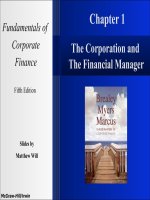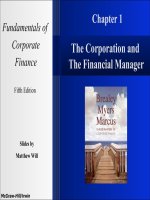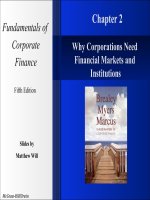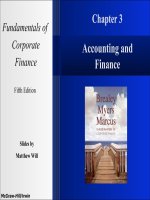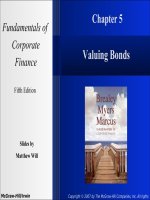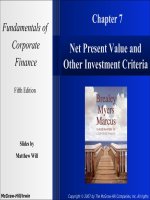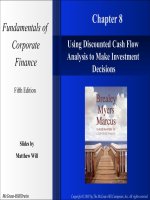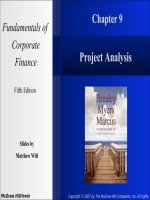Solution fundamentals of corporate finance brealy 4th chapter text solutions ch 12
Bạn đang xem bản rút gọn của tài liệu. Xem và tải ngay bản đầy đủ của tài liệu tại đây (192.33 KB, 11 trang )
Solutions to Chapter 12
The Cost of Capital
1.
The yield to maturity on the bonds (since maturity is now 19 years) is the interest
rate that solves the following equation:
90 annuity factor(r, 19 years) + 1000/(1 + r) 19 = 1050
The solution can be obtained most easily from a financial calculator: Set n = 19,
FV = 1000, PV = (-)1050, PMT = 90. Compute the interest rate as 8.46%. The
after-tax cost of debt is therefore 8.46% (1 – .35) = 5.50%.
2.
r = DIV/P0 = $4/$40 = .10 = 10%
3.
WACC = rdebt (1 – Tc) + rpreferred + requity
= .3 8.46% (1 – .35) + .2 10% + .5 12.5%
= 9.90%
4.
r = DIV1/P0 + g = + g = + .05 = .1375 = 13.75%
5.
The total value of the firm is $80 million. The weights for each security class are:
Debt:
Preferred:
Common:
D/V = 20/80 = .250
P/V = 10/80 = .125
E/V = 50/80 = .625
WACC = rdebt (1 – Tc) + rpreferred + requity
= .25 8% (1 – .35) + .125 10% + .625 15%
= 11.925%
6.
Executive Fruit should use the WACC of Geothermal, not its own WACC, when
evaluating an investment in geothermal power production. The risk of the project
determines the discount rate, and in this case, Geothermal’s WACC is more
reflective of the risk of the project in question. The proper discount rate, therefore,
is not 12.3%. It is more likely to be 11.4%.
7.
The flotation costs reduce the NPV of the project by $1.2 million. Then new NPV
is $2.5 million - $1.2 million, or $1.3 million. Even so, project NPV is still
positive, so the project should be undertaken.
121
Copyright © 2006 McGraw-Hill Ryerson Limited
8.
The rate on Buildwell’s debt is 5 percent. The cost of equity capital is the required
rate of return on equity, which can be calculated from the CAPM as 4% + .80
8% = 10.4%.
The weighted average cost of capital, with a tax rate of zero, is
WACC
=
rdebt
+ requity
= .30 (1 – 0) 5% + .70 10.4% = 8.78%
9.
IRR, which is 12%, exceeds the cost of capital. Therefore, BCCI should accept the
project. The present value of the project cash flows is
$100,000 annuity factor(8.78%, 7 years) = $507,032.
This is the most BCCI should pay for the project.
10.
Security
Market value
Explanation
Debt
Equity
$ 5.5 million
$15.0 million
1.10 par value of $5 million
$30 per share 500,000 shares*
Total
$20.5 million
*Number of shares = = 500,000
WACC = rdebt + requity
= (1 – .4) 9% + 15% = 12.42%
11.
Because the firm is all-equity financed, asset beta = equity beta = .8. The WACC is
the same as the cost of equity which may be calculated using the CAPM:
requity = rf + (rm – rf) = 5% + .8 × 10% = 13%
12.
The 12.5% value calculated by the analyst is the current yield of the firm’s
outstanding debt: interest payments/bond value. This calculation neglects the fact
that bonds selling at discounts from or premiums over par value provide expected
returns determined in part by expected price appreciation or depreciation. The
analyst should be using yield to maturity instead of current yield to calculate cost
of debt. [This answer assumes the value of the debt provided is the market value.
If it is the book value, then 12.5% would be the average coupon rate of
outstanding debt, which also would be a poor estimate of the required rate of
122
Copyright © 2006 McGraw-Hill Ryerson Limited
return on the firm’s debt.] Furthermore, if the analyst were interested in the firm’s
after-tax cost of debt, he or she would use (1 - t) × 12.5%.
13.
a.
Using the recent growth rate of 30% and the dividend yield of 2%, one
estimate would be:
DIV1/P0 + g = .02 + .30 = .32 = 32%
In this calculation, we’ve assumed that the current dividend yield is the next
expected dividend divided by the current price, DIV 1/P0. However, if the
dividend yield was the most recent past dividend, DIV0/P0, then with 30%
dividend growth, DIV1/P0 would be .02 × 1.3 = .026 and the estimated
required rate of return would be .026 + .3 = .326, or 32.6%.
Another estimate, based on the CAPM, would be
r = rf + (rm – rf) = 4% + 1.2 8% = 13.6%
14.
b.
The estimate of 32% seems far less reasonable. It is based on an historic
growth rate that is impossible to sustain. No company can grow at 30%
forever. The [DIV1/P0 + g] rule requires that the growth rate of dividends
per share must be viewed as highly stable over the foreseeable future. In
other words, it requires us to use the sustainable growth rate.
a.
The 9% coupon bond has a yield to maturity of 10% and sells for 93.86% of
face value:
n = 10, i = 10%, PMT = 90, FV = 1000, compute PV = $938.55
The market value of the issue is therefore
.9386 $20 million = $18.77 million
The 10% coupon bond sells for 92.8% of par value, and has a yield to
maturity of 11.0%:
n = 15, PV = ()928, PMT = 100, FV = 1000, compute i = 11.00%
The market value of the issue is
.928 $25 million = $23.20 million
The weighted average before-tax cost of debt is therefore
10% + 11% = 10.55%
123
Copyright © 2006 McGraw-Hill Ryerson Limited
b.
15.
The after-tax cost of debt is (1 – .35) 10.55% = 6.86%
The bonds must be selling below par value, because the YTM is greater than the
coupon rate.
The price per $1000 par value is
80 annuity factor(9%, 10 years) + 1000/1.0910 = $935.82
The total market value of the bonds is
$10 million par value = $9.36 million
Book value of the preferred shares is $2 million and the par value per share is $20.
Thus there are 100,000 shares of preferred stock (=$2 million/$20 per share).
Preferred shares are selling at $15 per share, for total market value of $1.5 million.
The market value of 1 million common shares selling at $20/share is $20 million.
The book value of the common shares is sum of the common stock plus retained
earnings, which also happens to equal $20 million.
Therefore, the market value capital structure is:
Bonds
Preferred Stock
Common Stock
Total
16.
Dollars
9.36 million
1.50 million
20.00 million
30.86 million
Percent
30.3%
4.9%
64.8%
100.0%
The yield to maturity on debt is r debt = 9%
The rate on preferred stock is rpreferred = $2/$15 = .133 = 13.3%
124
Copyright © 2006 McGraw-Hill Ryerson Limited
The rate on common stock is
requity = rf + (rm – rf) = 4% + 1.5 7% = 14.5%
Using the capital structure derived in the previous problem, we can calculate
WACC as:
WACC = rdebt + requity + rpreferred
= .303 (1 – .4) 9% + .648 14.5% + .049 13.3%
= 11.68%
17.
The IRR on the computer project is less than the WACC of firms in the computer
industry. Therefore, the project should be rejected. However, the WACC of the
firm (based on its existing mix of projects) is only 11.68%. If the firm uses this
figure as the hurdle rate, it will incorrectly go ahead with the venture in home
computers. The discount rate for a project is determined by the risk of the project.
University Product's WACC is irrelevant to the analysis of the investment in the
computer project.
18.
a.
r = rf + (rm – rf) = 4% + 1.5 7% = 14.5%
b.
Total market value of Muskoka Real Estate is $6 million and the market value
of the debt is $2 million. Thus the market value of its equity is $6 - $2, or $4
million. The current capital structure is 1/3 debt, 2/3 equity.
Weighted average beta = 0 + 1.5 = 1.0
c.
WACC = rdebt + requity
= (1 – .4) 4% + 14.5% = 10.47%
d.
If the company wishes to expand its present business then the WACC is a
reasonable estimate of the discount rate since the risk of the proposed project
is similar to the risk of the existing projects. Use a discount rate of 10.47%.
e.
The WACC of optical projects should be based on the risk of those projects.
Using a beta of 1.2, the discount rate for the new venture is
r = 4 + 1.2 7 = 12.4%
19.
a.
Equity
Market value = 10 million shares × $15/share = $150 million
rE = rf + rf + (rm – rf) = 2.5% + 1.2×6.5% = 10.3%
Debt
Market value per bond =
semi-annual coupon payment × PVIFA(6-month r B, no. of payments)
125
Copyright © 2006 McGraw-Hill Ryerson Limited
+ face value × PVIF(6-month r B, no. of periods to maturity)
rB = required rate of return on 10-year Gov't debt + 95 basis points
Required rate of return on 10-year Gov't debt = (1 + .04/2) 2 - 1 =.0404
rB = .0404 + .0095 = 0.0499 = 4.99%
6-month required rate of return = (1.0499)1/2 - 1 = .0246
Face value = 1000
Coupon payment= .06/2 × 1000 = 30
No. of payments = 2 payments/year × 10 years = 20
Market value per bond
= 30 PVIFA(.0246, 20) + 1000 × PVIF(.0246, 20) = $1,084.5
Market value of all bonds = 20,000 bonds × $1,084.5 = $21,690,000
WACC Calculation
Market Value
Market
Weight
Debt
$ 21,690,000
.126
Before-tax
Required
Rate of
Return
4.99%
Equity
Total
$150,000,000
$171,690,000
.874
10.3%
b.
After-tax
Required Rate
of Return
Weight ×
After-tax
Return
(1-.35)×4.99%
= 3.24%
10.3%
.408%
9.002%
9.41%
U =
To find debt , use the CAPM:
rdebt = rf + debt (rm – rf)
debt = = = .383
U =
= = 1.13
As expected, the unlevered beta is lower than the levered equity beta. With
no debt in the capital structure, the equity is less risky.
c.
Relever the equity beta to reflect the new capital structure of 50% debt:
levered = U + [U - debt] × D/E × (1 - TC)
= 1.13 + [1.13 - .383] × .5/.5 × (1 - .35) = 1.62
As expected, moving from a debt/equity ratio of .126/.874, or about .144 to .
5/.5, or 1, increases the riskiness of the equity. The levered equity beta
increases from 1.2 to 1.62. The new required rate of return to equity is:
rE = rf + (rm – rf) = 2.5% + 1.62×6.5% = 13.03%
126
Copyright © 2006 McGraw-Hill Ryerson Limited
The new WACC is:
WACC = rdebt × (1 - TC) + requity
= .5 4.99% (1 - .35) + .5 13.03% = 8.14%
20.
a.
The annual cash flows expected from Premier Pizza are:
Revenues - operating costs - capital expenditures
Percent of
Revenues
Revenues
Operating costs
Capital
expenditures
Annual after-tax
cash flows
.75
.05
Annual Cash Flow
$10 million
.75 × 10 million = 7.5 million
.05 × 10 million = 0.5 million
$2 million
The annual cash flows from Premier Pizza are a constant growing perpetuity.
Using the perpetuity formula, the present value of the cash flows is:
PV(annual cash flows) =
annual cash flow
required rate of return - growth rate
Required rate of return on cash flows:
WACC = rdebt × (1 - TC) + requity
= .3 × .06 × (1-.35) + .7 × .15 = .1167
PV(annual cash flows) = $2 million = $26.0756 million
.1167 - .04
If Boris and Isabelle offer $26.0756 million for Premier Pizza, the NPV of
their investment will be zero. The offer is the investment in the firm:
NPV = - investment + PV(future cash flows from firm)
= -26.0756 million - 26.0756 million = 0
The project will earn the required rate of return, just enough return to
compensate all investors. This is the maximum amount they should offer. If
they can purchase Premier Pizza for less than $26.0756 million, the
investment will earn more than the required rate of return, with the bulk of the
extra return going to the equity investors in the project.
b.
Fresh Foods current WACC
rEQUITY = rf + (rm – rf) = .03 + .8 × .07 = .086
rDEBT = .05
D/V = .4, E/V = .6
WACC = rdebt × (1 - TC) + requity
= .4 × .05 × (1 - .35) + .6 × .086 = .0646
127
Copyright © 2006 McGraw-Hill Ryerson Limited
Using Fresh Food's current WACC as the required rate of return on Premier
Pizza gives a valuation of:
PV(annual cash flows) = $2 million = $81.3 million
.0646 - .04
This says that Premier Pizza is worth over 3 times more owned by Fresh
Foods than by Boris and Isabelle, even though both groups expect the same
cash flows! The difference comes solely from the different discount rates.
Question: What is the appropriate discount rate for Fresh Foods to use in
valuing Premier Pizza? If you use Fresh Foods' current WACC, you are
assuming that riskiness of the pizza manufacturing business is the same as the
riskiness of the grocery retail business. Why should it necessarily be the
case?
Without further investigation, the better assumption would be that the
appropriate discount rate for Fresh Foods to use for Premier Pizza's cash
flows is 11.67%, the rate used by Boris and Isabella. We know that Boris and
Isabelle investigated the risks of the business before determining the
appropriate discount rate. Under this assumption, the maximum Fresh Foods
should be willing to pay is also $26.0756 million.
21.
If Big Oil does not pay taxes, the after-tax and before-tax costs of debt are
identical. WACC would then become:
WACC = rdebt + requity
= .243 9% + .757 13.5% = 12.41%
If Big Oil issues new equity and uses the proceeds to pay off all of its debt, the
cost of equity will fall. There is no longer any leverage, so the equity becomes
safer and commands a lower risk premium. In fact, with all-equity financing, the
cost of equity would be the same as the firm’s WACC, which is 12.41%, lower
than the previous value of 13.5%. (We use the WACC derived in the absence of
interest tax shields since, for the all-equity firm, there is no interest tax shield.)
22.
The net effect of Big Oil’s transaction is to leave the firm with $200 million more
debt (because of the borrowing) and $200 million less equity (because of the
dividend payout). Total assets and business risk are unaffected. The WACC will
remain unaffected, since business risk is unchanged. However, the cost of equity
will rise. With the now higher leverage, the business risk is spread over a smaller
equity base, so each share is now riskier.
The new financing mix for the firm would be E = 1,000 and D = 585.7. Therefore,
= = .369
and
= = .631.
128
Copyright © 2006 McGraw-Hill Ryerson Limited
If the cost of debt is still 9%, then we can solve for the new cost of equity as
follows. We use the fact that, even at the new financing mix, WACC must still be
12.41%.
WACC = rdebt + requity
= .369 9% + .631 requity = 12.41%
We solve to find that requity = 14.40%
23.
Even if the WACC were lower when the firm’s tax rate is higher, this does not
imply that the firm would be worth more. The after-tax cash flows that the firm
would generate for its owners also would be lower and this would reduce the
value of the firm, even if those cash flows were discounted at a lower rate. If the
tax authority is collecting more income from the firm, the value of the firm will
fall.
24.
This reasoning is faulty in that it implicitly treats the discount rate for the project
as the cost of debt if the project is debt financed, and as the cost of equity if the
project is equity financed. In fact, if the project poses risk comparable to the risk
of the firm’s other projects, the proper discount rate is the firm’s cost of capital,
which is a weighted average of the costs of both debt and equity.
25.
Internet: Calculating WACC of Canadian Companies
Expected results: This question gives students enough information to get a rough
estimate of companies' current WACC.
26.
Standard & Poor's: Calculate WACC of U.S. Companies
Tips: The free corporate bond credit spread data has been removed from Bonds
Online. Instead, they provide an example of credit spreads, dated June 30, 2004.
Tell your students to assume that these credit spreads are still valid. The new web
address for spreads is: />Expected results: Similar to Problem 25, this question gives students the
opportunity to estimate WACC for companies.
129
Copyright © 2006 McGraw-Hill Ryerson Limited
Solution to Minicase for Chapter 12
Bernice needs to explain to her boss, Mr. Brinestone, that appropriate rates of
return for cost of capital calculations are the rates of return that investors can earn on
comparable risk investments in the capital market. Mr. Brinestone’s estimate of the cost
of equity is his target value for the book return on equity; it is not the expected rate of
return that investors demand on shares of stock with the same risk as Sea Shore Salt.
Bernice’s CAPM calculation indicates that the correct value for the equity rate is
11%. This value is broadly consistent with the rate one would infer from the constant
growth dividend discount model (which seems appropriate for a mature firm like this
one with stable growth prospects). The dividend discount model implies a cost of equity
of a bit more than 11 percent:
requity = + g = + .067 = .117 = 11.7%
This value is close to Bernice's value. It is not surprising that the different methods for
estimating the cost of equity yield different values. However, it is reassuring that the
values are similar. For the rest of the solution we will use 11% as the cost of equity.
Mr. Brinestone’s returns for other securities should be modified to reflect the
expected returns these securities currently offer to investors. The bank loan and bond
issue offer pre-tax rates of 7.75% and 8%, respectively, as in Mr. Brinestone’s memo. It
is acceptable to use the interest rates on the loan and the debt as the required rates of
return given the information provided. We are told the "bank charged interest at the
current rate", which implies that the bank loan rate is a floating rate and hence changes
when market rates change. We are told that the bonds were just issued. The convention
is to set the bond coupon rate at the bond's required rate of return so that the bond will
be sold at par value. The preferred stock, however, is not selling at par, so Mr.
Brinestone’s assertion that the rate of return on preferred is 6% is incorrect. In fact, with
the preferred selling at $70 per share, the rate of return is
rpreferred = = = .086 = 8.6%
This makes sense: the pre-tax return on preferred should exceed that on the firm’s debt.
Finally, the weights used to calculate the WACC should reflect market, not book,
values. These are the prices that investors would pay to acquire the securities. The
market value weights are computed as follows:
Amount
Percent
Rate of
Comment
(millions)
of total
return
(%)
Bank loan
valued at face amount
$120
17.91
7.75
Bond issue
valued at par
80
11.94
8.0
Pfd. stock
$70 1 million shares
70
10.45
8.6
Common stock $40 10 million shares
400
59.70
11.0
$670
100.00
1210
Copyright © 2006 McGraw-Hill Ryerson Limited
Therefore, the WACC, which serves as the corporate hurdle rate, should be 9%:
WACC = .1791 7.75% (1 – .35) + .1194 8% (1 – .35)
+ .1045 8.6% + .5970 11% = 8.99%
1211
Copyright © 2006 McGraw-Hill Ryerson Limited
